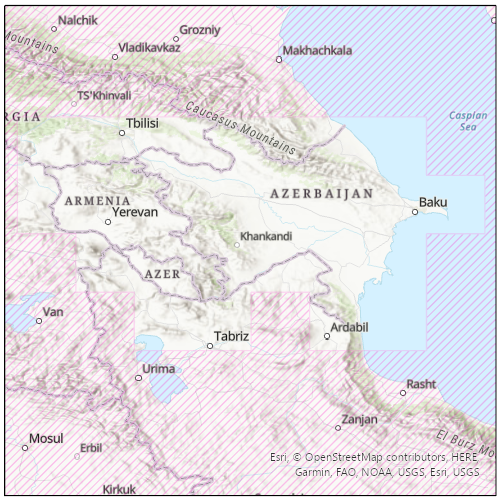Digital Elevation Models¶
Digital Elevation Models are required when processing SAR data to higher-level products, such as the Radiometric Terrain Correction (RTC) and Interferometric SAR (InSAR) products available On Demand from ASF.
In the past, ASF maintained a collection of DEMs that were pre-processed as appropriate for SAR workflows, and applied a preference hierarchy so that the best available DEM in any given area would be automatically selected for processing. With the public release of the GLO-30 Copernicus DEM, we have changed our DEM strategy to leverage a cloud-hosted copy of the global Copernicus DEM. This is now the only DEM option available for processing RTC and InSAR products.
Removal of option to use Legacy DEMs for RTC Processing
Users no longer have the option to use legacy DEMs when processing RTC jobs On Demand in Vertex or when using the API or SDK. The Copernicus GLO-30 DEM is now used for all RTC processing.
We use the 2022 Release of the Copernicus GLO-30 Public DEM, available on AWS.
Coverage gaps in Copernicus DEM GLO-30 filled using GLO-90
The 2022 release of the Copernicus DEM GLO-30 dataset does not provide coverage over Armenia and Azerbaijan. In the past, we have not supported On Demand product generation over those areas, due to the lack of DEM coverage. We now use the Copernicus DEM GLO-90 to fill those gaps.
The GLO-90 dataset has a pixel spacing of 90 meters, which is not as detailed as the 30-m pixel spacing in the GLO-30 DEM, but it does allow us to provide On Demand products in these regions, where they were previously unavailable.
Table 1 summarizes ASF's source DEM. The Copernicus GLO-30 DEM is now the only option available for both RTC and InSAR processing. Note that the DEM is reprojected to the UTM Zone (WGS84) appropriate for the granule location, and a geoid correction is applied before being used for processing. For RTC processing, the DEM is resampled to the pixel spacing of the output product. For InSAR processing, the DEM is resampled to twice the pixel spacing of the output InSAR product (160 m for 20x4 looks, 80 m for 10x2 looks).
| Resolution | DEM | Vertical Datum | Area | Posting | Priority |
|---|---|---|---|---|---|
| Medium | GLO-30 | EGM2008 | Global | 1 arc second | Default |
Table 1: DEM used for On Demand processing. The Copernicus DEM is the only option available when processing RTC and InSAR products.
When ordering On-Demand products, you can choose to include a copy of the DEM used for processing in the output product package. For RTC products, this DEM copy is converted to 16-bit signed integer format, but is otherwise the same as the DEM used in the RTC process. For InSAR products, the DEM copy is output in 32-bit float format, and is upsampled from the DEM resolution used for processing to match the pixel spacing of the output InSAR products.
Note that the height values will differ from the original source DEM in all cases, due to the geoid correction applied to prepare the DEM for use in SAR processing.
Copernicus DEM¶
The GLO-30 Copernicus DEM provides global coverage at 30-m pixel spacing (with the current exception of an area covering Armenia and Azerbaijan, see Figure 2).
When an On Demand job is requested, we download the required DEM tiles from the Copernicus Digital Elevation Model (DEM) GLO-30 Public dataset available in the Registry of Open Data on AWS, managed by Sinergise. We mosaic the tiles and reproject them to the appropriate UTM Zone for the location of the SAR granule to be processed, resampling them as required for processing. A geoid correction is applied before it is used for On Demand processing.
For the area that does not have coverage with the GLO-30 DEM, we use the Copernicus DEM GLO-90 dataset, which provides elevation data at 90-meter pixel spacing. Users ordering products over this area should be aware that a lower-resolution DEM is used for processing.
Figure 1 shows the coverage of the Copernicus DEM GLO-30 Public dataset, and Figure 2 details the land area currently only covered by the GLO-30 DEM at 90-m pixel spacing.

Figure 1: Copernicus DEM GLO-30 coverage map

Figure 2: Detail of area currently not covered by Copernicus DEM GLO-30. On Demand jobs requested over this area will use the Copernicus DEM GLO-90.
Special Use DEMs¶
AutoRIFT, a process developed by the NASA MEaSUREs ITS_LIVE project, uses custom Greenland and Antarctica DEMs with 240-m resolution. The DEM, associated process input files, and their details are available on the ITS_LIVE project website.